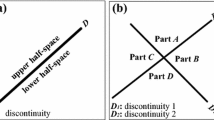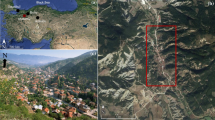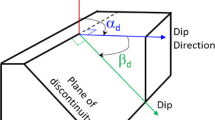Abstract
This paper presents an easy and effective methodology that includes several submodels for the visual characterisation of the wedge structures, locations, and densities of all faced in situ polyhedral rock blocks on rock slope surfaces. A series of linear equations and classifying processes was derived to define the natural wedge blocks according to their basic boundary elements, specifically their edges, corners, and angles. In the developed model, wedge structures can be selected by a filtering process from the generated data set, which was recorded by using the scan-line technique. The study defines the intersection points between discontinuity traces on free surfaces. Kernel density estimation, a clustering tool, was used to display the density of 2D intersection points on the free surfaces of a rock slope. The developed methodology will help reduce rock structure complexity for many assessments related to rock mass applications, such as slope stability. The methodology was sampled on an experimental highway wall, and the results were consistent.











Similar content being viewed by others
References
Aydan O, Kumsar H (2010) An experimental and theoretical approach on the modelling of sliding response of rock wedges under dynamic loading. Rock Mech Rock Eng 43(6):821–830
Cao Y (2013) Bivariate kernel density estimation (computer code). http://www.mathworks.com/matlabcentral/fileexchange/19280-bivariant-kernel-density-estimation–v2-1. Accessed 01 May 2014
Cundall PA (1971) A computer model for simulating progressive, large scale movement in blocky rock system. Paper presented at the symposium ISRM, Nancy, France
Elmouttie MK, Poropat GV, Krahenbuhl G (2010) Polyhedral modelling of rock mass structure. Int J Rock Mech Min Sci 47:544–552
Goodman RE (1989) Introduction to rock mechanics, 2nd edn. Wiley, New York
Goodman RE, Shi G (1985) Block theory and its application to rock engineering. Prentice-Hall international series in civil engineering and engineering mechanics. Prentice-Hall, Englewood Cliffs
Heliot D (1988) Generating a blocky rock mass. Int J Rock Mech Min Sci Geomech Abstr 25(3):127–138
Hoek E, Bray JW (1981) Rock slope engineering, revised, 3rd edn. The Institution of Mining and Metallurgy, London
International Society for Rock Mechanics (ISRM) (2007) The complete ISRM suggested methods for rock characterization, testing and monitoring: 1974–2006. In: Ulusay, Hudson (eds) Suggested methods prepared by the commission on testing methods. ISRM Turkish National Group, Ankara
Jimenez R (2009) Fuzzy spectral clustering for identification of rock discontinuity sets. Rock Mech Rock Eng 41:929–939
Jing L, Stephansson O (2007) The basics of fracture system characterization—field mapping and stochastic simulations. J Dev Geotech Eng 85:147–177
Karadağ MM, Küpeli Ş, Arık F, Ayhan A, Zedef V, Döyen A (2009) Rare Earth element (REE) geochemistry and genetic implications of the Mortaş bauxite deposit (Seydişehir—Konya-Southern Turkey). Chemie der Erde-Geochem 69:143–159
Kliche CA (1999) Rock slope stability. Society for Mining, Metallurgy, and Exploration, Inc. (SME)
Kovári K, Fritz P (1975) Stability analysis of rock slopes for plane and wedge failure with the aid of a programmable pocket calculator. 16th US rock mechanical symposium, Minneapolis, pp 25–33
Kovári K, Fritz P (1984) Recent development in the analysis and monitoring of rock slopes. In: Proceedings of the IV international symposium on landslide, Toronto, Canada
Lin D, Fairhurst C, Starfield AM (1987) Geometrical identification of three dimensional rock block system using topological techniques. Int J Rock Geomech Abstr 24(6):331–338
Lu J (2002) Systematic identification of polyhedral rock blocks with arbitrary joints and faults. Comput Geotech 29:49–72
Lucy D, Aykroyd RG, Pollard AM (2002) Non-parametric calibration for age estimation. Appl Stat 51:183–196
Maerz NH, Germain P (1996) Block size determination around underground openings using simulations. In: Proceedings of the FRAGBLAST 5 workshop on measurement of blast fragmentation, Montreal, Quebec, Canada, 23–24 Aug, 1996, pp 215–223
Monod O (1977) Recherches geoloqies dans le Taurus Occidental au Sud de Beyşehir (Turquie): Unpublished Phd thesis, Paris Univ
Parzen E (1962) On estimation of a probability density function and mode. Ann Math Stat 33:1065–1076
Priest SD (1985) Hemispherical production methods in rock mechanics. George Allen & Unwin, London
Priest S (1993) Discontinuity analysis for rock engineering. Chapman and Hall, London
Riquelme JR, Abellán A, Tomás R, Jaboyedoff M (2014) A new approach for semi-automatic rock mass joints recognition from 3D point clouds. Comput Geosci 68:38–52
Rosenblatt M (1956) Remarks on some nonparametric estimates of a density function. Ann Math Stat 27:832–837
SRTM (Shuttle Radar Topography Mission) Tile Grabber. http://dwtkns.com/srtm/. Accessed 15 March 2015
Turanboy A, Ülker E (2008) LIP-RM: an attempt at 3D visualization of in situ rock mass structures. Comput Geosci 12(2):181–192
Wang LG, Yamashita S, Sugimoto F, Pan C, Tan G (2003) A methodology for predicting the in situ size and shape distribution of rock blocks. Rock Mech Rock Eng 36(2):121–142
Warburton PM (1983) Applications of a new computer model for reconstructing blocky rock geometry—analysing single block stability and identifying keystones. In: 5th International congress on rock mechanics. ISRM, Melbourne, pp F225–F230
Whıttle P (1958) On the smoothing of probability density functions. J R Stat Soc B 20:334–343
Wittke W (1967) Influence of the shear strength of the joints on the design of pre-stressed anchors to stabilize a rock slope. Norwegian Geotech Inst, Oslo, pp 311–318
Yoon WS, Jeong UJ, Kim JH (2002) Kinematic analysis for sliding failure of multi-faced rock slopes. Eng Geol 67(1–2):51–61
Author information
Authors and Affiliations
Corresponding author
Rights and permissions
About this article
Cite this article
Turanboy, A. 2D visual characterisation of wedge failure types and locations on rock slopes. Environ Earth Sci 75, 1022 (2016). https://doi.org/10.1007/s12665-016-5820-1
Received:
Accepted:
Published:
DOI: https://doi.org/10.1007/s12665-016-5820-1




